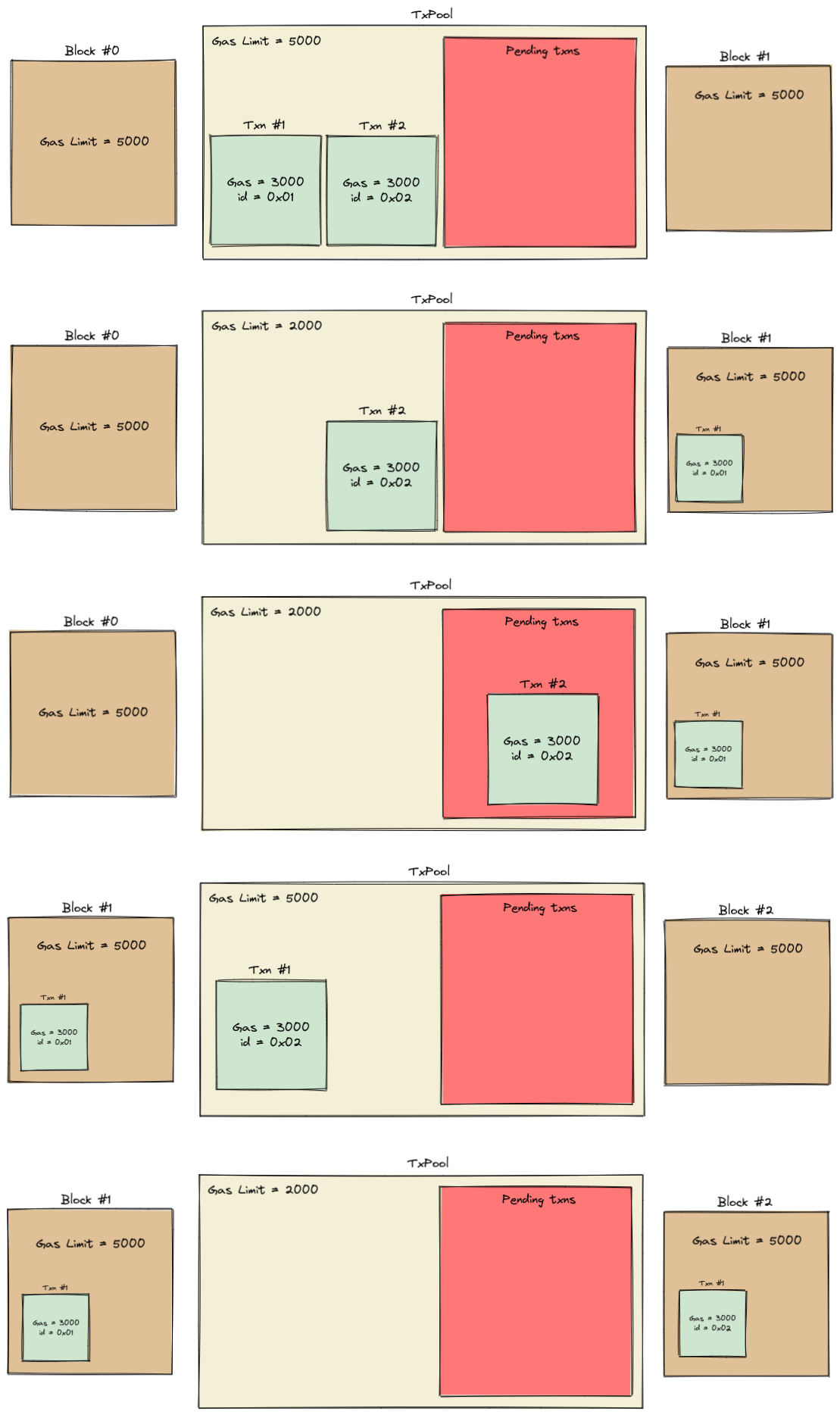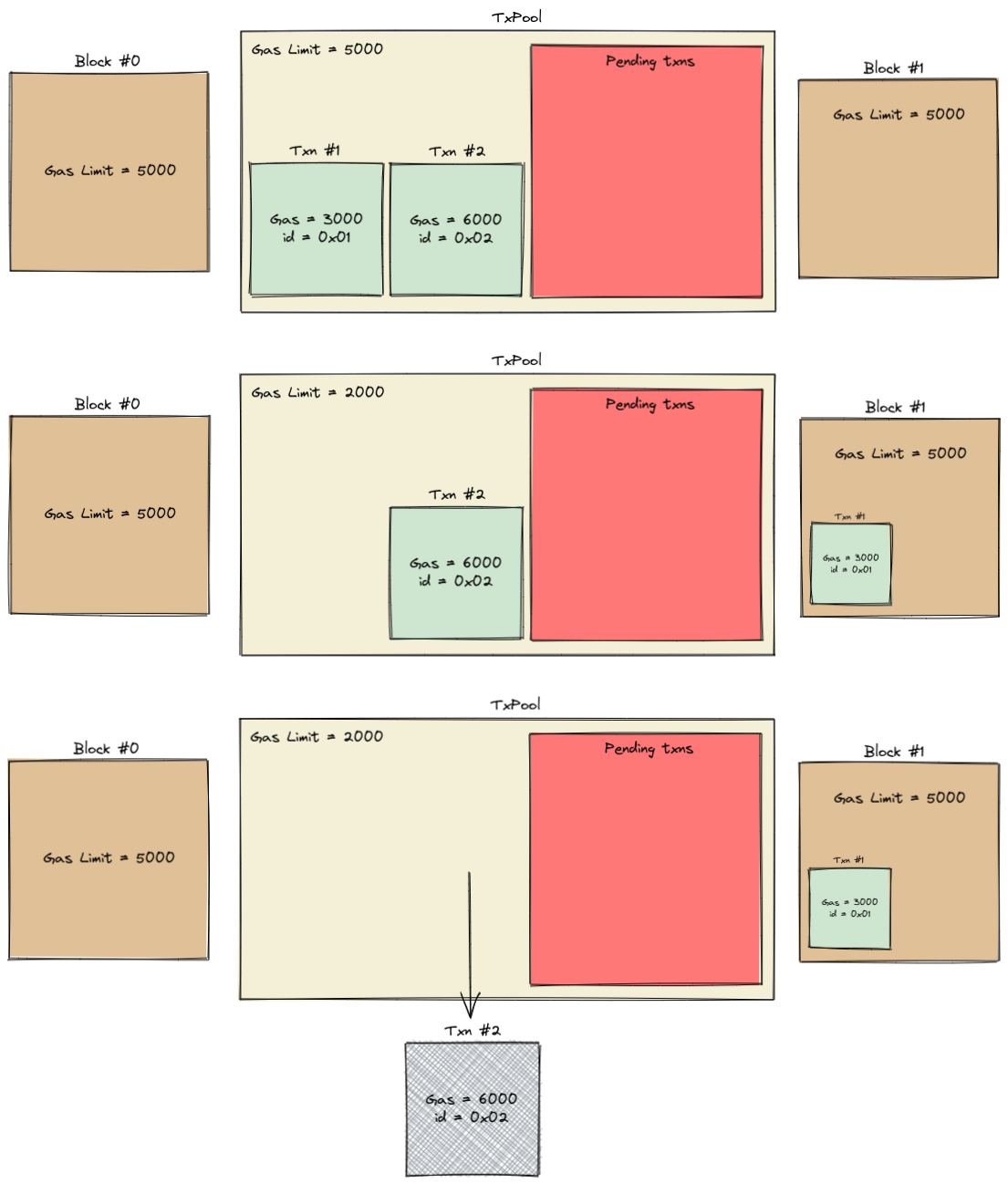TxPool
Overview
The TxPool module represents the transaction pool implementation, where transactions are added from different parts of the system. The module also exposes several useful features for node operators, which are covered below.
Operator Commands
service TxnPoolOperator {
// Status returns the current status of the pool
rpc Status(google.protobuf.Empty) returns (TxnPoolStatusResp);
// AddTxn adds a local transaction to the pool
rpc AddTxn(AddTxnReq) returns (google.protobuf.Empty);
// Subscribe subscribes for new events in the txpool
rpc Subscribe(google.protobuf.Empty) returns (stream TxPoolEvent);
}
Node operators can query these GRPC endpoints, as described in the CLI Commands section.
Processing Transactions
// AddTx adds a new transaction to the pool
func (t *TxPool) AddTx(tx *types.Transaction) error {
if err := t.addImpl("addTxn", tx); err != nil {
return err
}
// broadcast the transaction only if network is enabled
// and we are not in dev mode
if t.topic != nil && !t.dev {
txn := &proto.Txn{
Raw: &any.Any{
Value: tx.MarshalRLP(),
},
}
if err := t.topic.Publish(txn); err != nil {
t.logger.Error("failed to topic txn", "err", err)
}
}
if t.NotifyCh != nil {
select {
case t.NotifyCh <- struct{}{}:
default:
}
}
return nil
}
func (t *TxPool) addImpl(ctx string, txns ...*types.Transaction) error {
if len(txns) == 0 {
return nil
}
from := txns[0].From
for _, txn := range txns {
// Since this is a single point of inclusion for new transactions both
// to the promoted queue and pending queue we use this point to calculate the hash
txn.ComputeHash()
err := t.validateTx(txn)
if err != nil {
return err
}
if txn.From == types.ZeroAddress {
txn.From, err = t.signer.Sender(txn)
if err != nil {
return fmt.Errorf("invalid sender")
}
from = txn.From
} else {
// only if we are in dev mode we can accept
// a transaction without validation
if !t.dev {
return fmt.Errorf("cannot accept non-encrypted txn")
}
}
t.logger.Debug("add txn", "ctx", ctx, "hash", txn.Hash, "from", from)
}
txnsQueue, ok := t.queue[from]
if !ok {
stateRoot := t.store.Header().StateRoot
// initialize the txn queue for the account
txnsQueue = newTxQueue()
txnsQueue.nextNonce = t.store.GetNonce(stateRoot, from)
t.queue[from] = txnsQueue
}
for _, txn := range txns {
txnsQueue.Add(txn)
}
for _, promoted := range txnsQueue.Promote() {
t.sorted.Push(promoted)
}
return nil
}
The addImpl method is the bread and butter of the TxPool module. It is the central place where transactions are added in the system, being called from the GRPC service, JSON RPC endpoints, and whenever the client receives a transaction through the gossip protocol.
It takes in as an argument ctx, which just denotes the context from which the transactions are being added (GRPC, JSON RPC...).
The other parameter is the list of transactions to be added to the pool.
The key thing to note here is the check for the From field within the transaction:
- If the From field is empty, it is regarded as an unencrypted/unsigned transaction. These kinds of transactions are only accepted in development mode
- If the From field is not empty, that means that it's a signed transaction, so signature verification takes place
After all these validations, the transactions are considered to be valid.
Data structures
// TxPool is a pool of transactions
type TxPool struct {
logger hclog.Logger
signer signer
store store
idlePeriod time.Duration
queue map[types.Address]*txQueue
sorted *txPriceHeap
// network stack
network *network.Server
topic *network.Topic
sealing bool
dev bool
NotifyCh chan struct{}
proto.UnimplementedTxnPoolOperatorServer
}
The fields in the TxPool object that can cause confusion are the queue and sorted lists.
- queue - Heap implementation of a sorted list of account transactions (by nonce)
- sorted - Sorted list for all the current promoted transactions (all executable transactions). Sorted by gas price
Gas limit error management
Whenever you submit a transaction, there are three ways it can be processed by the TxPool.
- All pending transactions can fit in a block
- One or more pending transactions can not fit in a block
- One or more pending transactions will never fit in a block
Here, the word fit means that the transaction has a gas limit that is lower than the remaining gas in the TxPool.
The first scenario does not produce any error.
Second scenario
- The TxPool remaining gas is set to the gas limit of the last block, lets say 5000
- A first transaction is processed and consumes 3000 gas of the TxPool
- The remaining gas of the TxPool is now 2000
- A second transaction, which is the same as the first one - they both consume 3000 units of gas, is submitted
- Since the remaining gas of the TxPool is lower than the transaction gas, it cannot be processed in the current
block
- It is put back into a pending transaction queue so that it can be processed in the next block
- The first block is written, lets call it block #1
- The TxPool remaining gas is set to the parent block - block #1's gas limit
- The transaction which was put back into the TxPool pending transaction queue is now processed and written in the block
- The TxPool remaining gas is now 2000
- The second block is written
- ...

Third scenario
- The TxPool remaining gas is set to the gas limit of the last block, lets say 5000
- A first transaction is processed and consumes 3000 gas of the TxPool
- The remaining gas of the TxPool is now 2000
- A second transaction, with a gas field set to 6000 is submitted
- Since the block gas limit is lower than the transaction gas, this transaction is discarded
- It will never be able to fit in a block
- The first block is written
- ...

This happens whenever you get the following error:
2021-11-04T15:41:07.665+0100 [ERROR] polygon.consensus.dev: failed to write transaction: transaction's gas limit exceeds block gas limit
Block Gas Target
There are situations when nodes want to keep the block gas limit below or at a certain target on a running chain.
The node operator can set the target gas limit on a specific node, which will try to apply this limit to newly created blocks.
If the majority of the other nodes also have a similar (or same) target gas limit set, then the block gas limit will always hover
around that block gas target, slowly progressing towards it (at max 1/1024 * parent block gas limit) as new blocks are created.
Example scenario
- The node operator sets the block gas limit for a single node to be
5000 - Other nodes are configured to be
5000as well, apart from a single node which is configured to be7000 - When the nodes who have their gas target set to
5000become proposers, they will check to see if the gas limit is already at the target - If the gas limit is not at the target (it is greater / lower), the proposer node will set the block gas target to at most (1/1024 * parent gas limit) in the direction of the target
- Ex:
parentGasLimit = 4500andblockGasTarget = 5000, the proposer will calculate the gas limit for the new block as4504.39453125(4500/1024 + 4500) - Ex:
parentGasLimit = 5500andblockGasTarget = 5000, the proposer will calculate the gas limit for the new block as5494.62890625(5500 - 5500/1024)
- Ex:
- This ensures that the block gas limit in the chain will be kept at the target, because the single proposer who has the target configured to
7000cannot advance the limit much, and the majority of the nodes who have it set at5000will always attempt to keep it there